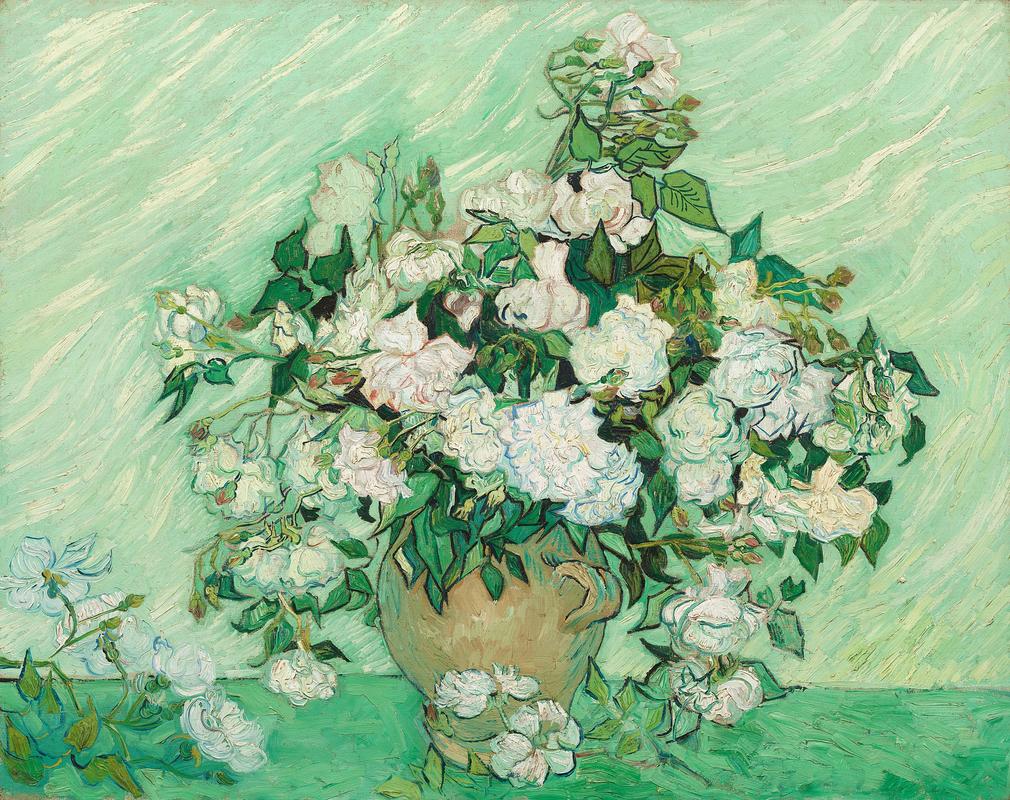More about Roses
- All
- Info
- Shop

Contributor
Vincent van Gogh was incarcerated in 1890 and left the asylum with a series of floral paintings.
That’s how Vincent van Gogh came to paint his 1890 floral enchantment Roses, from an asylum in Saint-Remy. These gorgeous drops of snow grew in the asylum’s garden. There were plenty of flowers in the garden for patients and staff to enjoy. Vincent took notice of them and began painting canvas after canvas of kaleidoscopic bouquets. Roses was one of many.
Vincent painted Roses, along with three other floral paintings, a week before his departure from the asylum. Vincent painted these over seven days in May. There are two versions of Roses, and they’re distinguished apart with the canvas; one is horizontal and the other a portrait. These four bouquets on canvases were left behind to dry before being shipped over to Auvers in late June, before Vincent’s death.
Cutting off your ear will get you a first-class ticket to the asylum, unfortunately, Vincent was not spared. An epileptic attack set off a bout of mental illness. This act of self-harm sent Vincent in and out of hospitals and asylums when finally we reach Saint-Remy.
Time takes its toll on mortal beings and paintings. Museums have experts restoring priceless works of art. While Vincent’s Roses appears undamaged, technology has revealed that time has in fact worn off the paint. It’s believed Vincent used a red lake pigment to add flakes of red to the white roses. And this experiment failed long-term causing the roses to look like snow white drops. What he attempted to achieve was a vibrant contrast of colors, pink against green. The breakdown of the pigments caused the red to turn to white and ultimately Roses was left to resemble Minties on a green tablecloth.
Sources
- BBC, “Van Gogh self-portrait is genuine, experts decide,” January 20, 2020. Accessed February 16, 2020. https://www.bbc.com/news/entertainment-arts-51188829
- Boztas, Senay, “Van Gogh ‘sick’ self-portrait verified as a crucial work by Amsterdam museum after decades of uncertainty,” The Telegraph, January 20, 2020. Accessed February 16, 2020. https://www.telegraph.co.uk/news/2020/01/20/van-gogh-sick-self-portrai
- Distel, Anne, “Gachet, Father and Son,” Cezanne to Van Gogh: The Collection of Doctor Gachet, edited by Anne Distel and Susan Alyson Stein. New York: Harry N. Abrams, Inc., 1999.
- Scoop Team, “Van Gogh: Incredible Style And Technique,” Scoop Empire, December 24, 2019. Accessed 23 February, 2020. https://scoopempire.com/van-gogh-incredible-style-and-technique/
- Smith, Roberta, “Review: ‘Van Gogh: irises and Roses,’ Sheds Light on a Disappearing Red Hue,” The New York Times, May 21, 2015. Accessed February 16, 2020. https://www.nytimes.com/2015/05/22/arts/design/review-van-gogh-irises-a…
- The New York Times, “Looking at van Gogh, 125 Years Later,” July 29. 2015. Accessed February 16, 2020. https://www.nytimes.com/interactive/2015/07/29/arts/design/looking-at-v…
Featured Content
Here is what Wikipedia says about Still Life: Vase with Pink Roses
Still Life: Vase with Pink Roses was painted in 1890 by Vincent van Gogh in Saint-Rémy. At the time the work was painted Van Gogh was readying himself to leave the Saint-Rémy asylum for the quiet town of Auvers-sur-Oise outside of Paris. This and the similarly-dated Pink Roses reflect the optimism Van Gogh felt at that time about his future, both in his choice of flowers as a subject and the colors used. The painting is owned by the National Gallery of Art of Washington, D.C.
Check out the full Wikipedia article about Still Life: Vase with Pink Roses














I like this painting because the stoke lines bring texture to the piece, making it more interesting. The faded colors and the texture in the piece remind me of something I might see in 18th-century impressionism art in Europe.